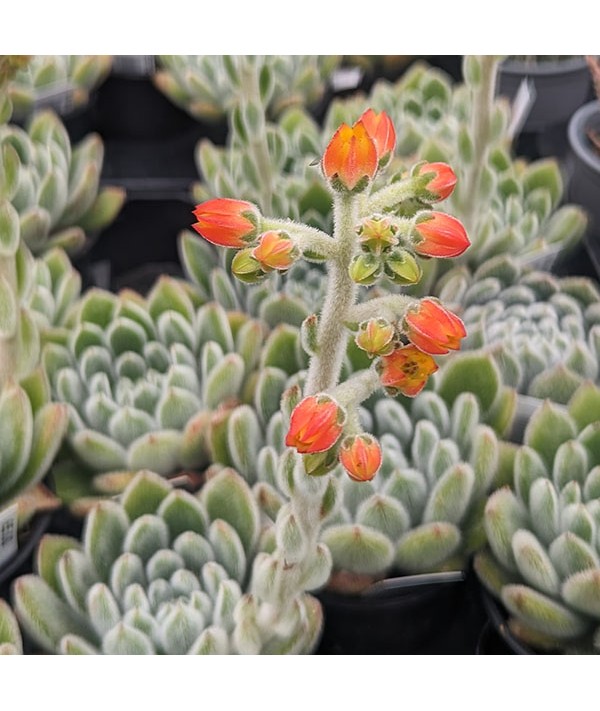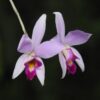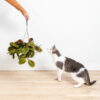When it comes to our beloved pets, their safety is always a top priority. One way to ensure their well-being is by carefully selecting the plants we keep in our homes. The Mexican Firecracker, also known as Echeveria Setosa, is a popular choice for many plant enthusiasts. Not only is it visually appealing, but it’s also non-toxic to both dogs and cats. This makes it an excellent addition to pet-friendly households.
Article-at-a-Glance
- The Mexican Firecracker is a non-toxic plant, making it safe for both dogs and cats.
- This plant thrives best in well-draining soil and requires ample sunlight.
- Water the Mexican Firecracker sparingly, allowing the soil to dry out between watering sessions.
- Place the plant out of reach of curious pets to prevent accidental ingestion.
- Monitoring your pet’s interaction with plants can help ensure their safety.
Ensuring Pet Safety Around Mexican Firecracker (Echeveria Setosa)
Understanding the characteristics of the Mexican Firecracker and how to care for it is essential for maintaining a pet-friendly environment. This plant is part of the non-toxic category, which means that even if your pet decides to take a nibble, there won’t be any harmful consequences. However, it’s always wise to keep a watchful eye on your furry friends and their interactions with household plants.
“Echevera setosa (Mexican Firecracker …” from langthorns.com and used with no modifications.
Understanding Non-Toxic Nature of Echeveria Setosa
The Mexican Firecracker is a succulent, which means it has thick, fleshy leaves that store water. Unlike some plants that contain harmful compounds, this plant is free from toxins that could harm pets. Here’s why it’s considered non-toxic:
- It lacks harmful compounds like calcium oxalate crystals, which are found in many toxic plants.
- The plant does not cause vomiting or diarrhea if ingested in small amounts.
- It is recognized by the ASPCA as a safe plant for pets.
Most importantly, having non-toxic plants like the Mexican Firecracker in your home can provide peace of mind, knowing that your pets are not at risk of poisoning from a curious nibble.
Why Choosing Pet-Safe Plants is Essential
Choosing pet-safe plants is not just a precaution; it’s a necessary step in creating a harmonious living space for both plants and pets. Many common houseplants can pose significant risks if ingested by pets. Symptoms can range from mild stomach upset to severe neurological issues.
By selecting plants that are non-toxic, you eliminate the potential for these dangers. It’s a simple yet effective way to protect your pets while still enjoying the beauty and benefits that houseplants bring to your home. Therefore, knowing which plants are safe is crucial for any pet owner.
Key Characteristics of Mexican Firecracker
Beyond its non-toxic nature, the Mexican Firecracker boasts several appealing characteristics that make it a favorite among plant lovers. Its unique appearance and ease of care are just a couple of reasons why it’s so popular.
Growth Size and Appearance
The Mexican Firecracker is a compact succulent that typically grows to about 6 inches tall and 8 inches wide. Its rosettes are made up of soft, hairy leaves that can vary in color from green to a reddish hue, depending on the amount of sunlight it receives. This plant can also produce bright red flowers, which add a splash of color and make it even more attractive.
Distinguishing Features: Leaf and Flower Attributes
One of the most distinctive features of the Mexican Firecracker is its leaves. They are covered in fine, white hairs that give the plant a fuzzy appearance. This not only adds to its charm but also helps to reduce water loss, making it well-suited for arid environments. For pet owners, understanding the social benefits of pet ownership can enhance the experience of having such unique plants around.
The flowers of the Mexican Firecracker are another highlight. They bloom on tall, slender stalks and are usually bright red or orange, resembling tiny firecrackers. This striking contrast against the green foliage makes the plant a standout addition to any collection.
- Leaves are thick and fleshy, ideal for water storage.
- Flowers are vibrant and tubular, attracting pollinators like hummingbirds.
Caring for the Mexican Firecracker
Taking care of the Mexican Firecracker is relatively straightforward, which makes it a great choice for both novice and experienced plant enthusiasts. This succulent is not only resilient but also quite forgiving, making it easy to maintain. By providing the right conditions, you can enjoy a healthy and vibrant plant that complements your home. For more detailed care instructions, you can visit PictureThis.
Understanding the specific needs of the Mexican Firecracker will ensure it thrives in your care. Let’s explore the essentials, from soil and sunlight to watering and temperature requirements.
Ideal Soil and Sunlight Requirements
The Mexican Firecracker thrives best in well-draining soil, which is crucial for preventing root rot. Succulent or cactus potting mixes are ideal because they provide the necessary drainage. If you prefer to make your own mix, consider combining regular potting soil with sand or perlite to improve drainage.
Sunlight is another critical factor in the health of your Mexican Firecracker. This plant loves bright, indirect light. While it can tolerate some direct sunlight, too much can cause the leaves to scorch. Therefore, placing it near a south-facing window or under a grow light can provide the perfect balance.
- Use a pot with drainage holes to prevent water accumulation.
- Avoid placing the plant in low-light areas as it may lead to leggy growth.
- Rotate the plant occasionally to ensure even light exposure.
By mimicking the plant’s natural habitat, you can encourage robust growth and vibrant colors.
Watering Guidelines
When it comes to watering, less is more with the Mexican Firecracker. Overwatering is one of the most common mistakes made with succulents, leading to root rot and other issues. The key is to allow the soil to dry out completely between watering sessions.
During the growing season, which is typically spring and summer, you may need to water your plant every two to three weeks. In the dormant winter months, reduce watering to once a month or less, depending on the humidity levels in your home. If you’re a senior who loves gardening but finds it challenging to maintain plants, consider exploring solutions for seniors unable to care for pets that might also apply to plant care.
Optimal Temperature and Humidity Levels
The Mexican Firecracker prefers temperatures between 65°F and 80°F, which aligns with most indoor environments. It can tolerate occasional dips in temperature, but prolonged exposure to cold can damage the plant.
Humidity is not a significant concern for this succulent, as it is adapted to arid conditions. However, if your home is particularly humid, ensure good air circulation around the plant to prevent fungal issues. For more information on caring for this plant, visit this Echeveria Setosa care guide.
In summary, providing the right care for your Mexican Firecracker is about finding the balance between light, water, and temperature. By doing so, you can enjoy a healthy and thriving plant.
“The Mexican Firecracker is a hardy plant that can brighten up any space with minimal effort. Just remember: bright light, well-draining soil, and sparing water are key to its success.”
Pet Safety Concerns and Precautions
Even though the Mexican Firecracker is non-toxic, it’s always wise to take precautions to ensure your pets’ safety. Pets, especially cats and dogs, are naturally curious and may still interact with your plants. Here’s how you can create a safe environment for both your plants and your pets.
Potential Risks Despite Non-Toxic Nature
While the Mexican Firecracker doesn’t pose a significant risk, ingestion of any plant material can sometimes cause mild stomach upset in pets. Symptoms may include vomiting or diarrhea, although these are typically mild and resolve quickly.
If you notice your pet has ingested a large amount of the plant or is exhibiting unusual symptoms, it’s best to consult your veterinarian. They can provide guidance and reassurance to ensure your pet remains healthy.
Preventing Over-curiosity in Pets
To minimize the risk of your pets nibbling on your Mexican Firecracker, consider placing the plant out of reach. High shelves, hanging planters, or dedicated plant stands can be effective solutions. Additionally, training your pets to avoid certain areas or using pet-safe deterrents can help keep them away from your plants.
Ultimately, the goal is to create a harmonious environment where both your plants and pets can coexist safely. By taking a few simple precautions, you can enjoy the beauty of your Mexican Firecracker without worrying about your pets’ safety.
Steps to Minimize Ingestion Risk
Even though the Mexican Firecracker is non-toxic, it’s still a good idea to minimize any potential risks associated with pet ingestion. Here are some steps you can take to keep your pets safe, including understanding the importance of pet socialization to prevent accidental ingestion.
First, place your Mexican Firecracker in a location that is out of reach for your pets. High shelves or hanging planters are excellent options that can deter curious cats and dogs. Additionally, consider creating a designated plant area in your home where pets are not allowed. This not only protects your plants but also reduces the chances of any accidental ingestion. For more information on keeping your pets safe and happy, explore the importance of pet socialization.
Final Thoughts on Pet Safety
Incorporating pet-safe plants like the Mexican Firecracker into your home is a smart choice for ensuring your pets’ well-being. While this plant is non-toxic, taking preventative measures can further protect your furry friends. By understanding the care requirements of the Mexican Firecracker and monitoring your pets’ interactions with it, you can create a safe and harmonious environment for all.
Remember, the key to a pet-friendly home is awareness and preparation. By being proactive, you can enjoy the beauty of your plants without compromising the safety of your pets.
Balancing Plant Care and Pet Safety
Finding the right balance between plant care and pet safety can be challenging, but it’s not impossible. Start by choosing plants that are known to be non-toxic, like the Mexican Firecracker. Next, ensure that you provide the right conditions for your plants to thrive, such as proper lighting, soil, and watering. If you’re concerned about caring for pets while managing plant care, there are solutions available to help.
Monitoring Pet Interactions with Plants
Keeping an eye on how your pets interact with your plants is crucial. If you notice your pet showing interest in a particular plant, take action to redirect their attention. This can be done through training or by providing alternative forms of stimulation, like toys or treats. For more information on whether specific plants, such as Echeveria setosa, are toxic to pets, consult reliable sources.
Ultimately, creating a pet-friendly home is about understanding the needs of both your plants and your pets. By taking a few simple steps, you can ensure that both coexist peacefully and safely.
Frequently Asked Questions
As a pet owner, you might have some questions about the Mexican Firecracker and its impact on your pets. Here are answers to some common inquiries:
How large can a Mexican Firecracker grow?
The Mexican Firecracker is a compact succulent that typically grows to about 6 inches tall and 8 inches wide. Its small size makes it an ideal choice for indoor spaces and container gardens.
Are there any specific signs to watch for if my pet ingests the plant?
While the Mexican Firecracker is non-toxic, ingestion of any plant material can sometimes cause mild stomach upset in pets. Look for signs such as vomiting or diarrhea. These symptoms are usually mild and resolve on their own. However, if your pet has ingested a large amount or exhibits unusual behavior, contact your veterinarian for advice.
In conclusion, the Mexican Firecracker is a beautiful and safe addition to any pet-friendly home. By following the tips and guidelines provided, you can enjoy this plant’s vibrant beauty while ensuring your pets’ safety.






